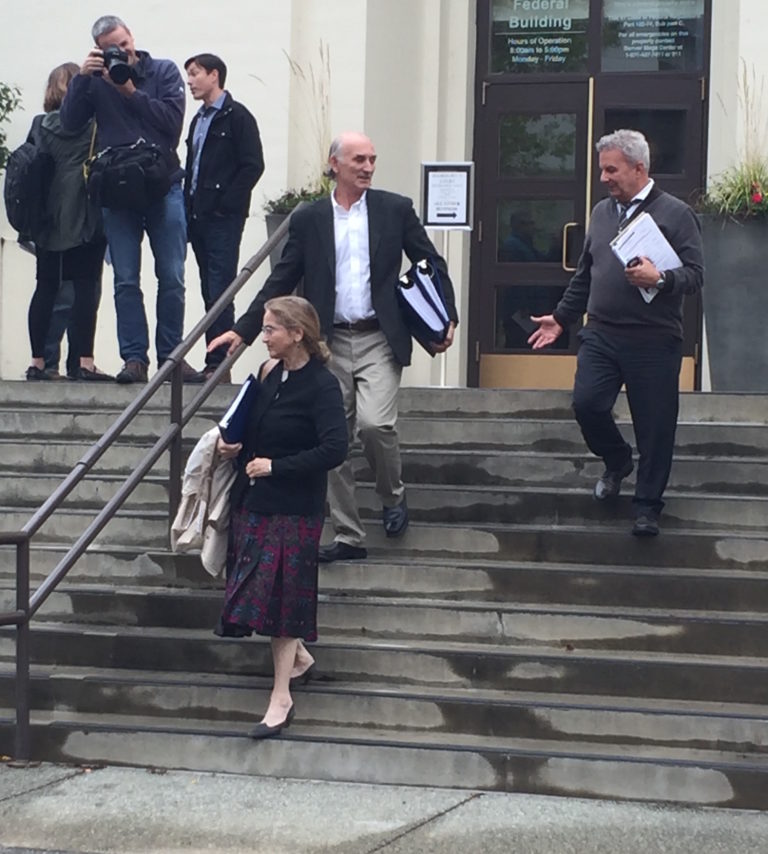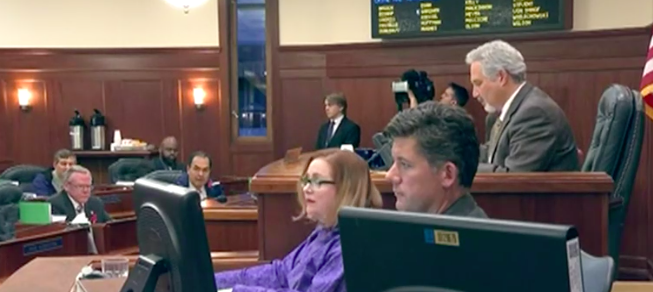THE MONEY THE CHINESE OFFER? $43 BILLION
Governor Bill Walker tonight will brief the Alaska Legislature on a deal he has struck with the Communist Chinese. The details of the meeting were embargoed, but press was sent an advisory about a media briefing to take place following the meeting with the Legislature, and a press release was posted this evening.
At 8:30 pm, legislators began filing to the Third Floor of the Capitol, where they are to meet in the Governor’s conference room to hear the briefing from the governor, who will conference in from China. There was secrecy around the meeting, which will not be televised to the public.
China state-controlled television pegged the LNG deal at $43 billion, about what the low estimate is for the cost of building the project.
Here is the contents of the release from the Governor’s Office:
BEIJING—It was a historic day for the State of Alaska and the United States as Governor Bill Walker signed the five-party joint development agreement (JDA) for the Alaska liquefied natural gas (Alaska LNG) project. This historic signing is the most significant step toward finally monetizing Alaska’s vast resources of natural gas. President Donald Trump and President Xi Jinping were present for the signing ceremony at the Great Hall of the People, underscoring the international importance of the agreement.
“Because Alaskans need well-paying jobs and affordable energy to power our homes, schools and businesses, this Alaska LNG project is critical,” Governor Walker said. “The gasline is key to building a Stronger Alaska. I thank President Trump for the full support he and his administration have shown for this project, as it brings the United States one step closer to energy dominance. When President Xi visited Anchorage six months ago, he shared with me his desire for deepening the mutually beneficial ties between China and Alaska. I thank him for expediting that vision to reality. I especially thank Commerce Secretary Wilbur Ross and his team for their strong belief in the Alaska LNG project, and all of the hard work they put into making this day happen.
“I also thank the Alaska Legislature for staying the course in funding the Alaska Gasline Development Corporation so the state could reach this historic milestone. Additionally, I thank BP, ConocoPhillips and ExxonMobil for recognizing the potential benefits to the State of Alaska when they offered in February of 2016 to transition the lead of the project to the State. AGDC President Keith Meyer, his staff and board members have worked tirelessly since that transition to bring Alaska to this point with the market. I thank them for their countless hours and sleepless nights.”
The joint development agreement was signed by the State of Alaska, AGDC and three of the largest Chinese energy and finance companies—Sinopec, Bank of China and China Investment Corporation.
- Sinopec, one of the largest oil and gas companies in the world, generates $456 billion in annual revenue.
- Bank of China is one of the five largest banks, with clients in more than 50 countries and regions.
- With an estimated $813.5 billion, China Investment Corporation is the world’s third largest sovereign wealth fund.
“This agreement has all five necessary signatories—the buyer, the lender, the investor, the developer and the state,” Governor Walker said. “This is a big project with big players and big benefits. There are more steps before a final investment decision is reached, but having the largest LNG buyer in the world participating in this project means the Alaska LNG project has favorable market engagement at the highest level. This project will finally allow Alaska to reach its full potential as a state. As we move from having one of the highest unemployment rates in the country to the lowest, we will build a Stronger Alaska.”
AGDC PRESS RELEASE DESCRIBES IT AS MOU, NOT A DEAL
The Alaska Gasline Development Corporation issued this press release which makes it sound more like a memorandum of understanding, and an expression of interest. It mentions no deal or agreement to fund the front-end engineering:
November 9, 2017 – Beijing, China – Alaska Gasline Development Corporation (AGDC), the State of Alaska, China Petrochemical Corporation (Sinopec), CIC Capital Corporation (CIC Capital), and Bank of China (BOC), today announced a joint development agreement to advance Alaska LNG, Alaska’s strategic gas infrastructure project.
The agreement was signed in the presence of United States President Donald Trump and China President Xi Jinping, and expresses the common interests in the preparatory work of Alaska LNG.
Alaska LNG is designed as a 20 million tonnes per annum (MTPA) integrated LNG system comprised of a three train liquefaction plant in Southcentral Alaska at Nikiski; an approximately 800 mile, 1.1 meter diameter gas pipeline; a gas treatment plant on the North Slope of Alaska; and various interconnecting facilities to connect the Prudhoe Bay gas complex to the gas treatment plant.
Under the agreement, the parties have agreed to work cooperatively on LNG marketing, financing, investment model and China content in Alaska LNG, and get a periodic result by 2018.
“Today’s agreement brings the potential customer, lender, equity investor, and developer together with a common objective of crafting mutually beneficial agreements leading to increased LNG trade between Alaska and China,” said Keith Meyer, president, AGDC.
“Sinopec is interested in the possibility of LNG purchase on a stable basis from Alaska LNG,” said Sinopec.
“This is an agreement that will provide Alaska with an economic boom comparable to the development of the Trans-Alaska Pipeline System in the 1970s,” said Governor Bill Walker, State of Alaska.
“CIC Capital is an experienced financial investor in the energy and infrastructure sectors and has long been interested in investing in American LNG infrastructure. CIC Capital is pleased to work with fellow industry and financial partners on this project,” said CIC Capital.
“As the most internationalized bank in China, Bank of China is willing to facilitate the China-U.S. energy cooperation and provide financial solutions for this transaction by taking advantage of its vast experiences and expertise in international mega-project financing,” said Bank of China.
Sinopec is a huge, state-owned, fully integrated energy and chemical company. Based in Beijing, Sinopec is the largest oil and gas company in the world by revenue with annual revenue of USD 455.49 billion.
CIC Capital is China’s direct investment arm, which is mandated to make direct investments and manage bilateral and multilateral fund investments in order to pursue long-term financial returns and promote international investment cooperation. CIC Capital is a market-oriented commercial entity with a specialized mandate and global reach. As a long-term financial investor, CIC invests on a commercial basis.
Bank of China is a state-owned commercial bank. Bank of China ranks top 10 largest banks in the world by market capitalization value and provides a comprehensive range of financial services to clients in 52 countries and regions around the world.
CHINA SPY SHIPS OFF ALASKA
Earlier this year, the Chinese had spy ships located about 100 miles off the coast of Alaska for several days, according to a report by CNN. The incident occurred just prior to the test of the U.S. missile defense system.
[Read: Chinese navy ships enter Alaska waters]
“US Navy Capt. Scott Miller, spokesperson for the North American Aerospace Defense Command, said the ship is believed to be a ‘communications’ or ‘intelligence’ vessel and confirmed it has been in the area for the last few days,” CNN reported in July. It was verified by other military officers.
CHINESE HUMAN RIGHTS WATCH
The Chinese are among the worst human rights violators on the planet. According to Human Rights Watch, which wrote this about the Chinese regime:
More than three decades after pledging to “reform and open up,” there are few signs the Chinese Communist Party intends to change its authoritarian posture. Under the leadership of President Xi Jinping, who will remain in power until 2022 and possibly beyond, the outlook for fundamental human rights, including freedoms of expression, assembly, association and religion, remains dire.
China made modest improvements in a few areas in 2016. These include trial regulations promulgated in February that may reduce the rate of pretrial detention, the Supreme People’s Court’s continued efforts to retry cases of wrongful convictions and executions, and the acceptance by courts of discrimination cases brought by lesbian, gay, bisexual, and transgender (LGBT) individuals. But such developments pale in comparison to the government’s systematic efforts to silence independent civil society voices, its passage of abusive new laws, and a highly politicized anti-corruption campaign that is further undermining an already weak judicial system.
Over 16 human rights lawyers and activists—detained after a nationwide sweep of rights advocates in July 2015—were the clearest victims of the authorities’ hostility towards independent civil society. Most were held in secret and not allowed to communicate with their families or lawyers of their choosing. Families, lawyers, and supporters who inquired about the cases or sought the detainees’ release also became targets of the authorities’ wrath.
The secrecy surrounding these detentions stood in stark contrast to the aggressive state media campaign to smear the detainees, many of them well-known for their years of activism. The publicity, which departed from the quieter treatments of past political trials such as that of Liu Xiaobo’s in 2009, appears designed to punish the activists and advance President Xi’s campaign to depict independent civil society as a national security threat.
Chinese authorities’ enforced disappearance of critics from Hong Kong and other countries in 2016 garnered headlines globally. Beijing’s decision to interfere in a politically charged court case in Hong Kong in November undermined judicial independence and the territory’s autonomy. In the ethnic minority regions of Xinjiang and Tibet, Beijing continued its highly repressive rule, curtailing political activity and many peaceful expressions of ethnic and religious identity.
Authorities also moved to further limit freedom of expression. In November, the government passed a Cybersecurity Law, which will strangle online freedom and anonymity, and further clamped down on media outlets for reporting that departs from the party line. Authorities also issued multiple directives to tighten control over the internet, which has long been a beacon of hope as a relatively free public space, despite online censorship and surveillance.
The Chinese government continues to lead the world in the number of people executed, with 46 crimes eligible for the death penalty. Scholars in China claimed in September that executions had “fallen about 60 percent” to “a few thousands” in 2005, but official statistics remain state secrets.
This story is developing and will be updated.





